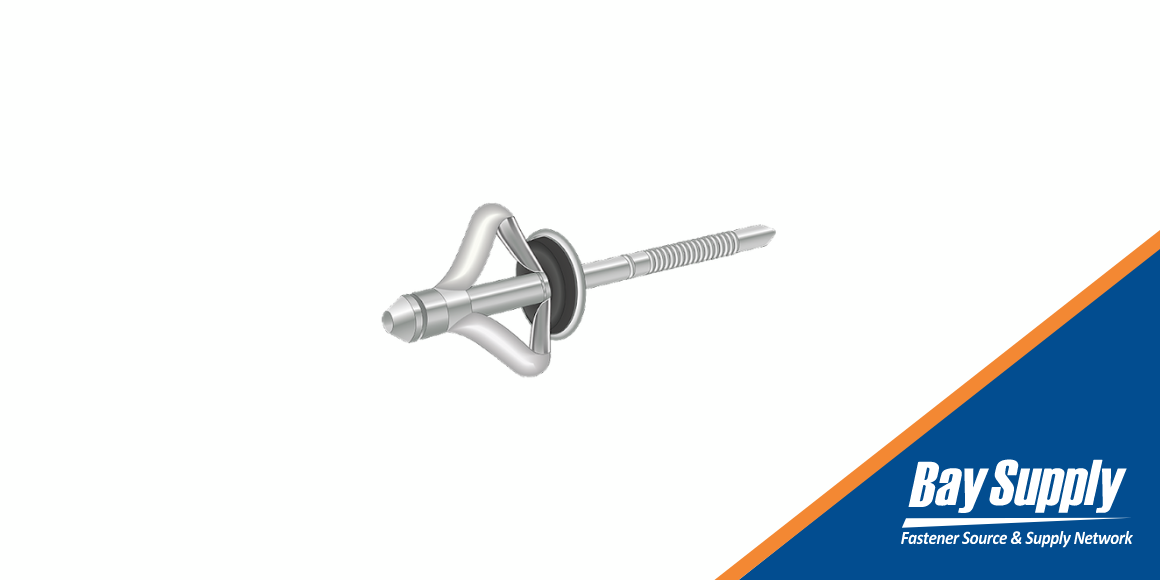
Humanity has used rivets for millennia, starting with the Egyptians more than 5,000 years ago. Because rivets have such a long history, they have evolved significantly over time, and today’s specialty rivets offer different tolerances for specific applications. Bulb-tite rivets continue to be one of the most versatile types of rivets.
Bulb-tite rivets are unique in how they distribute a joint's load. Bulb-tite rivets were developed to work with brittle materials and soft, pliable materials to expand on the blind side of a joint to provide more surface area to carry the stress, which prevents joints from failing or pulling out. Because bulb-tite rivets are so reliable and versatile, they are used for both structural and non-structural applications.
What Is a Bulb-Tite Rivet?
Bulb-tite rivets are blind rivets that have three load-bearing legs on the blind side. When installed by pulling the mandrel, the rivet collapses on the blind side into legs or petals that fit securely against the workpiece.
Bulb rivets are incredibly versatile and can be used with plastic, rubber, plasterboard, and soft or brittle materials without fear of pullout. They can also connect different materials, such as plastics and metal. Bulb rivets can also form a watertight seal, which makes them popular for construction, boatbuilding, hot tub manufacturing, and similar uses.
Most importantly, bulb-tite rivets deliver reliable performance. Bulb rivets are high-strength with superior clamping. They also offer a broad grip range, which makes them extremely versatile. In addition to being watertight, bulb rivets come in various finishes, providing a different aesthetic depending on the application.
Their superior performance makes bulb-tite rivets ideal for manufacturing and repairing aircraft, ships and submarines, shipping containers, trucks, and trailers. Bulb rivets can also attach metal roofing and applications exposed to the elements, such as solar panels, because they withstand weather-related corrosion.
Structural vs. Non-Structural Bulb Rivets
Bulb rivets are installed like any other blind rivet. The rivet is inserted in a pre-drilled hole, and a rivet tool pulls the mandrel to form the petals on the blind side. Bulb-tite rivets come in two basic designs: structural and non-structural.
Structural bulb rivets are for heavy-duty applications and use mandrels with a predetermined breaking point. When the mandrel is pulled, it shears off and locks into place, adding strength to the joint and ensuring it never falls out. Structural rivets can also be installed with washers to make the fastener watertight.
Non-structural bulb-tite rivets are for lighter-weight materials that don’t require the same shear and tensile strength. Unlike structural rivets, the mandrels of non-structural rivets do not lock in place.
Popular Structural Bulb-Tite Rivets
Most of the well-known fastener manufacturers make both structural and non-structural bulb rivets. Here are four of the most popular rivets sold on the Bay Supply Marketplace:
- GESIPA Bulb-Tite®—GESIPA makes bulb-tite blind rivets designed specifically for construction applications, although they have many other uses. The GESIPA bulb rivets are weatherproof, vibration-resistant, and multifunctional. They also have shaveable heads in 1/4, 3/16, and 5/32 inches in aluminum and steel.
- STANLEY (Avdel) BAPKTR—STANLEY offers the BAPKTR line of structural rivets as part of its Avdel Klamp-Tite line in 6.4mm and 4.8mm diameters. These all-aluminum bulb-tite rivets feature dome heads for a clean finish.
- Huck Magna-Tite®—Huck developed the Magna-Tite as a specialty aluminum fastener designed for repairs, including oversized holes. The Magna-Tite comes in 3/6-inch and 1/4-inch diameters; is ideal for use with materials such as aluminum, fiberglass, and plastics; and has an embedded sealant between the bolt and the sleeve.
- Bayfast BayTite—Bayfast offers the BayTite line of all-aluminum bulb fasteners in various diameters with different grip ranges.
Popular Non-Structural Bulb-Tite Rivets
The Bay Supply Marketplace also features a variety of non-structural bulb rivets, including:
- STANLEY (Avdel) Bulbex: The Avdel Bulbex is one of STANLEY Engineered Fastening’s non-structural bulb rivets. These bulb fasteners come in 5/32- and 3/16-inch diameters and a range of grip lengths to handle different diameters. They are made of aluminum alloy and are typically used with plastics and low-strength materials, including in the manufacturing of mobile homes, appliances, and plastic components.
- STANLEY (Avdel) Pop LSR: STANLEY also offers the Avdel Pop LSR (load-spreading rivet), a non-structural bulb-tite rivet designed to deliver reliability and a neat appearance when used to join soft and pliable materials. The Pop LSR works with wood, plastics, laminates, and other materials and is commonly used for applications such as making mobile homes, plywood furniture, plastic window frames, and more. The Pop LSR is made of a high-strength aluminum/magnesium alloy with a grip range of up to 12.0mm.
- GESIPA Tri-Fold®: The Tri-Fold aluminum blind rivets from GESIPA have a 4.8mm diameter and grip ranges from 1.0mm to 7.9mm. The GESIPA Tri-Fold features a dome head and can be used for joints and rivet repairs.
- Ornit Or-Bulb: The Ornit Or-Bulb is a split-tail aluminum fastener commonly used for transportation applications—such as automotive, trucking containers, and rail—to secure door panels, seats, and so on. The Or-Bulb split-tail rivet covers a large area on the blind side, prevents electrical problems and corrosion, and won’t come loose with vibration.
- Marson Tri-Bulb: Marson offers the Tri-Bulb blind rivets with a large blind-side footprint and multigrip capacity. The Tri-Bulb is ideal for use with oversized holes and comes in 5/32- to 3/16-inch diameters.
Bay Supply offers a wide variety of bulb-tite fasteners. To learn more about the best type of fastener for your next job, be sure to consult our Essential Guide to Blind Rivets and sign up for the Bay Supply Marketplace to see the types of bulb-tite blind rivets that are available.



Comments